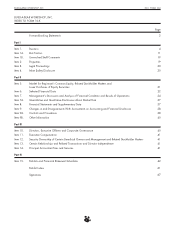Build-A-Bear Workshop 2011 Annual Report Download - page 19
Download and view the complete annual report
Please find page 19 of the 2011 Build-A-Bear Workshop annual report below. You can navigate through the pages in the report by either clicking on the pages listed below, or by using the keyword search tool below to find specific information within the annual report.
BUILD-A-BEAR WORKSHOP, INC. 2011 FORM 10-K
property rights or to determine the validity and scope of the
proprietary rights of others. Litigation of this type could result
in substantial costs and diversion of resources, may result in
counterclaims or other claims against us and could
significantly harm our results of operations. In addition, the
laws of some foreign countries do not protect our proprietary
rights to the same extent as do the laws of the United States.
We also conduct business in foreign countries to the
extent our merchandise is manufactured or sold outside the
United States and we have opened stores outside the
United States either directly or indirectly through
franchisees. We filed, obtained or plan to file for registration
of marks in foreign countries to the degree necessary to
protect these marks, although our efforts may not be successful
and there may be restrictions on the use of these marks in
some jurisdictions.
SEGMENTS AND GEOGRAPHIC AREAS
We conduct our operations through three reportable segments
consisting of retail, international franchising, and
commercial. The retail segment includes the operating
activities of company-owned stores in the United States,
Canada, the United Kingdom and Ireland, and other retail
operations, including our web-store and non-traditional store
locations such as tourist venues, temporary locations and
ballpark stores. The commercial segment includes our
transactions with other business partners, mainly comprised of
licensing our intellectual property, including entertainment
properties, for third-party use and wholesale product
sales. The international franchising segment includes the
activities under our franchise agreements with locations in
Asia, Australia, Africa, the Middle East, Europe, Mexico and
South America.
Our reportable segments are primarily determined by the
types of customers they serve and the types of products and
services that they offer. Each reportable segment may operate
in many geographic areas. See the financial statements
included elsewhere in this Annual Report on Form 10-K for
further discussion and financial information related to our
segments and the geographic areas in which we operate.
AVAILABILITY OF INFORMATION
We make certain filings with the SEC, including our Annual
Report on Form 10-K, quarterly reports on Form 10-Q, current
reports on Form 8-K, and all amendments and exhibits to
those reports, available free of charge in the Investor Relations
section of our corporate website, http://ir.buildabear.com, as
soon as reasonably practicable after they are filed with the
SEC. The filings are also available through the SEC at the
SEC’s Public Reference Room at 100 F Street, N.E.,
Washington, D.C. 20549 or by calling 1-800-SEC-0330.
Also, these filings are available on the internet at
http://www.sec.gov. Our Annual Reports to shareholders,
press releases and recent analyst presentations are also
available on our website, free of charge, in the Investor
Relations section or by writing to the Investor Relations
department at World Bearquarters, 1954 Innerbelt Business
Center Dr., St. Louis, MO 63114.
ITEM 1A. RISK FACTORS
We operate in a changing environment that involves
numerous known and unknown risks and uncertainties that
could materially affect our operations. The risks, uncertainties
and other factors set forth below may cause our actual results,
performances or achievements to be materially different from
those expressed or implied by our forward-looking statements.
If any of these risks or events occur, our business, financial
condition or results of operations may be adversely affected.
RISKS RELATED TO OUR BUSINESS
A decline in general global economic conditions could lead to
disproportionately reduced consumer demand for our
products, which represent relatively discretionary spending,
and have an adverse effect on our liquidity and profitability.
Since purchases of our merchandise are dependent upon
discretionary spending by our guests, our financial
performance is sensitive to changes in overall economic
conditions that affect consumer spending. Consumer spending
habits are affected by, among other things, prevailing
economic conditions, levels of employment, salaries and
wage rates, consumer confidence and consumer perception of
economic conditions. A continued slowdown in the
United States, Canadian or European economies or
uncertainty as to the economic outlook could reduce
discretionary spending or cause a shift in consumer
discretionary spending to other products. Any of these factors
would likely cause us to delay or slow our expansion plans,
result in lower net sales and could also result in excess
inventories, which could, in turn, lead to increased
merchandise markdowns and related costs associated with
higher levels of inventory and adversely affect our liquidity
and profitability. For example, the slower economy in the
United States and Europe has caused our sales to decline and
led us to slow our growth plans.
A decrease in the customer traffic generated by the shopping
malls in which we are located, which we depend upon to
attract guests to our stores, could adversely affect our
financial condition and profitability.
While we invest heavily in integrated marketing efforts and
believe we are more of a destination location than traditional
retailers, we rely to a great extent on customer traffic in the
malls in which our stores are located. In order to generate
guest traffic, we generally attempt to locate our stores in
prominent locations within high traffic shopping malls. We
rely on the ability of the malls’ anchor tenants, generally large
department stores, and on the continuing popularity of malls
as shopping destinations. We cannot control the development
of new shopping malls, the addition or loss of anchors and
11
























